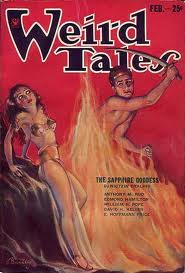Robert E. Howard may have invented Sword & Sorcery with the first King Kull tale, but he was not the only author working with the raw materials of heroic fantasy. We have already mentioned C. L. Moore and her Jirel of Joiry stories, which were published at the same time as Conan. There were other authors who penned stories that bordered on S&S but were not quite for one reason or another.
 The first and most obvious of these quasi-S&S writers was Howard’s friend, Clark Ashton Smith, who wrote around 100 stories in his most productive years, some Science Fiction, but most his own ornate style of fantasy for Weird Tales. These include “The Tale of Satampra Zeiros” (November 1931), “The Empire of the Necromancers” (September 1932), “The Isle of the Torturers” (March 1933), “The Death of Malygris” (April 1934) and “Necromancy in Naat” (July 1936) but my selection of the most S&S like would be “The Carnal God” (March 1934) which features two lovers torn apart by a weird death cult and their eventual escape. A rare happy ending for Smith. Another would be “The Black Abbott of Puthuum” (March 1936) which features two warriors, Zobal the Archer and Cushara the pikebearer. What keeps Smith from becoming Sword & Sorcery is an entirely different point, purpose or perspective than Robert E. Howard. Where Howard set his heroes against foes, Smith’s characters are closer to Lovecraft’s, victim-like protagonists. But unlike Lovecraft, Smith looks at them sardonically, like an evil god laughing at their futile and silly ways. We are never invited to share or empathize in their adventures.
The first and most obvious of these quasi-S&S writers was Howard’s friend, Clark Ashton Smith, who wrote around 100 stories in his most productive years, some Science Fiction, but most his own ornate style of fantasy for Weird Tales. These include “The Tale of Satampra Zeiros” (November 1931), “The Empire of the Necromancers” (September 1932), “The Isle of the Torturers” (March 1933), “The Death of Malygris” (April 1934) and “Necromancy in Naat” (July 1936) but my selection of the most S&S like would be “The Carnal God” (March 1934) which features two lovers torn apart by a weird death cult and their eventual escape. A rare happy ending for Smith. Another would be “The Black Abbott of Puthuum” (March 1936) which features two warriors, Zobal the Archer and Cushara the pikebearer. What keeps Smith from becoming Sword & Sorcery is an entirely different point, purpose or perspective than Robert E. Howard. Where Howard set his heroes against foes, Smith’s characters are closer to Lovecraft’s, victim-like protagonists. But unlike Lovecraft, Smith looks at them sardonically, like an evil god laughing at their futile and silly ways. We are never invited to share or empathize in their adventures.
 Nictzin Dyalhis is a one trick pony that came very close to emulating Robert E. Howard, though he may not have intended to do so. His most famous story is “The Sapphire Siren” (February 1934). This tale begins in our own reality, where a man is taken to another dimension by a wizard named Zarf. The earthman finds out he was once King Karan, a hero as well as a monarch. The two fighting deadly Vulmin dwarves before setting off to find Agnor Halit, the only wizard who can restore Karan’s memory taken by another wizard, Djl Grm. He takes on a retainer, the red giant Koto, before setting out over the Sea of the Dead, the Hills of Flint and the Mountains of Horror. Fortunately, Koto’s dad is a genii who takes them to their destination. Halit sends the party to retrieve the Sapphire Siren, a blue statuette of a woman. This turns out to be Karan’s long lost bride and the story ends with a show-down.
Nictzin Dyalhis is a one trick pony that came very close to emulating Robert E. Howard, though he may not have intended to do so. His most famous story is “The Sapphire Siren” (February 1934). This tale begins in our own reality, where a man is taken to another dimension by a wizard named Zarf. The earthman finds out he was once King Karan, a hero as well as a monarch. The two fighting deadly Vulmin dwarves before setting off to find Agnor Halit, the only wizard who can restore Karan’s memory taken by another wizard, Djl Grm. He takes on a retainer, the red giant Koto, before setting out over the Sea of the Dead, the Hills of Flint and the Mountains of Horror. Fortunately, Koto’s dad is a genii who takes them to their destination. Halit sends the party to retrieve the Sapphire Siren, a blue statuette of a woman. This turns out to be Karan’s long lost bride and the story ends with a show-down.
So much of what Dyalhis does echoes future writers of Sword & Sorcery that it is hard not to say it is, in fact, the real deal. Where it falls down is the hero’s origins in our world, and his disbelief in the whole adventure. This is more familiar to fans of the Harold Shea style of fantasy that will be published at Astounding by John Campbell in the 1940s. The man-from-our-world will appear in Robert E. Howard’s posthumously published Almuric (1939), an Edgar Rice Burroughs styled Science Fantasy, as well as in Andre Norton’s Witch World series (1963). Sadly, Dyalhis didn’t write a series of King Karan tales.
 Edmond Hamilton is well known as “World Wrecker” Hamilton, star of space opera for Captain Future and other series, but he wrote 73 stories for Weird Tales. A number of these were not-quite-heroic fantasy, including several set in mythological settings. “The Avenger From Atlantis” (July 1935), “Child of Atlantis” (December 1937), “The Isle of the Sleeper” (May 1938), “Dreamer’s World” (November 1941), “The Priestess of the Labyrinth” (January 1945), “The King of Shadows” (January 1947), “Serpent Princess” (January 1948) and “Twilight of the Gods” (July 1948). These tales often involve a person from our time or other non-S&S elements.
Edmond Hamilton is well known as “World Wrecker” Hamilton, star of space opera for Captain Future and other series, but he wrote 73 stories for Weird Tales. A number of these were not-quite-heroic fantasy, including several set in mythological settings. “The Avenger From Atlantis” (July 1935), “Child of Atlantis” (December 1937), “The Isle of the Sleeper” (May 1938), “Dreamer’s World” (November 1941), “The Priestess of the Labyrinth” (January 1945), “The King of Shadows” (January 1947), “Serpent Princess” (January 1948) and “Twilight of the Gods” (July 1948). These tales often involve a person from our time or other non-S&S elements.
 So far all the authors mentioned have been found in Weird Tales. But Frederick Arnold Kummer Jr. (a Science Fiction and Mystery writer) penned a tale for the Ziff-Davis Fantastic Adventures that comes close to heroic fantasy, if only a pale version. “Adventure in Lemuria” (Fantastic Adventures, May 1939) follows Khor the Wanderer as he fights the bull god in the arena. It’s not Conan but you can feel the author approaching Sword & Sorcery. He followed it with a few more quasi-S&`S pieces , “Intrigue in Lemuria” (Fantastic Adventures, July 1939) and “Volcano Slaves of Mu” (Fantastic Adventures, March 1940) but they had little or not impact.
So far all the authors mentioned have been found in Weird Tales. But Frederick Arnold Kummer Jr. (a Science Fiction and Mystery writer) penned a tale for the Ziff-Davis Fantastic Adventures that comes close to heroic fantasy, if only a pale version. “Adventure in Lemuria” (Fantastic Adventures, May 1939) follows Khor the Wanderer as he fights the bull god in the arena. It’s not Conan but you can feel the author approaching Sword & Sorcery. He followed it with a few more quasi-S&`S pieces , “Intrigue in Lemuria” (Fantastic Adventures, July 1939) and “Volcano Slaves of Mu” (Fantastic Adventures, March 1940) but they had little or not impact.
These writers were certainly aware of Robert E. Howard but the works they created were not necessarily inspired by them. The next group of writers to come would be a different story: Clifford Ball and Henry Kuttner would pick up the torch dropped by the man from Texas.











Recent Comments